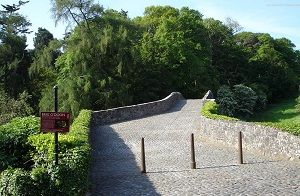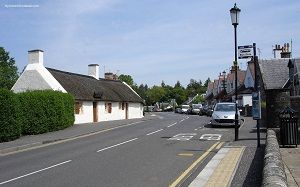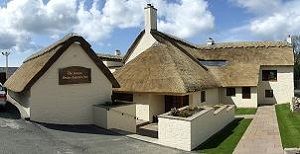|
|
|
Image from New Bridge. The poem tells of a local in the area that was returning from a day at the market in old Ayr. After having a few drinks, he passes by Alloway’s haunted Old Kirk (church) and stumbles across witches. In his desperate attempt to escape, he rides his grey mare Meg across this bridge hoping the witches would be reluctant to cross the water. Although Tam escapes their clutches, Meg looses her tail to the grasp of a witches hand. |
|
|
|
|
|
|
The Burns Monument and Memorial Gardens designed by Thomas Hamilton, as seen to the right of the hotel, were completed in 1823 with the gardens opening to the public on the 4th July of that year. The gardens also contain statues of Tam O Shanter and Souter Johnnie. About 50,000 people are said to visit the gardens each year. More Information & Photos of the Gardens. |
|
|
|
|
Alloway Parish Church, built in 1858, is directly across the road from the Auld Kirk. Large Image of William Burns Headstone, |
|
|
|
|
The Burns Museum is open daily. Admission charges
to the museum are about adults £12 . The Gift
Shop and Cafe are free to visit. |
|
|
|
|
This short walk has many Statues and Weather Vanes mentioned in his famous Poems. Large Image. |
|
|
|
At the end of the Poets Walk, you reach Alloway Main Street, with Burns Birthplace Cottage, the entrance and large car park are at the rear of the Cottage. William Burness built this Cottage in 1757. He had moved from Kincardineshire to Alloway in 1750 to work as a Gardener in the neighbouring Doonholm Estate. |
|
|
Robert Burns has remained a favourite of the Scottish people, as his life saw him stay in many parts of the country. This means there are buildings and monuments throughout Scotland that have been preserved in his name and become part of Scotland’s history. Also, he was the father of 12 children to 4 different women; this also adds interest to his life. The Burness family left the cottage in 1765 to take up a 12-year lease of the nearby farm named Mount Oliphant. From there, Robert attended a small School in Alloway. By 1777, the family had leased Lochlea farm in the parish of Tarbolton, about 8 miles north of Alloway. William Burness died at Lochlea in February 1784, leaving Robert as head of the family.The Bachelors' Club in the village of Tarbolton has been preserved by the National Trust as it was where Robert took Dancing Lessons and formed a Debating Club in the upper room. Robert and his brother Gilbert then rented Mossgiel farm at Mauchline, about 4 miles north of Tarbolton. Robert met his future wife Jean Armour at Mauchline in 1785. He wrote some of his finest works at that time and began to earn a small income from their sales. It is thought he changed his name to Burns during that period. In about 1786, Robert fell in love with Highland Mary who worked at Coilsfield Castle & Estate, situated on the outskirts of Tarbolton. Burns referred to Coilsfield Castle as Montgomery Castle, the name of the owners. Robert and Mary intended to emigrate to the West Indies around that time. Mary died soon after from a fever, this seeing Robert decide to remain in Scotland. Robert returned to Jean Armour with them getting married in Mauchline in 1788. Coilsfield Castle was replaced by Coilsfield House in about 1804, that house was destroyed by fire in 1969. The Walled Garden of the Estate now serves as a holiday park under the name Middlemuir Heights. In 1788, Robert Burns and Jean Armour moved to the farm of Ellisland in the parish of Dumfries about 50 miles southeast of Mauchline. By 1791, he had taken up residence in Dumfries itself and lived there until his death on the 21st July 1796, aged 37. His death was atrributed to either Rheumatic Heart Disease or Alcoholism. He was buried in St Michael’s Churchyard Dumfries on the day his wife Jean was giving birth to their ninth child. Burns Night is an annual celebration held throughout Scotland on the 25th January, the anniversary of his birth. Many Robert Burns descendants can be seen on photograph at: sites.scran.ac.uk/robertburns/descendants/ or in the Burns Museum in Alloway. |
|
|
|
|
This Cottage, built in 1785, was the home of John Davidson, the local Souter (Scots for Shoemaker). Davidson became the character Johnnie Souter who was Tam’s drinking partner in Burns famous poem Tam O Shanter. Burns got to know Davidson when at sixteen years old; he spent the summer of 1775 at a school in Kirkoswald learning mathematics. Most of the characters in the tale of Tam O Shanter were from Kirkoswald, and are Buried in the Old Church Yard there. The Cottage is now owned by the National Trust for Scotland. It is open to the public from April 1st - September 30th 11.30 - 17.00, admission is now Free. The Cottage contains Period Furniture, Burns Relics, a Souters Workshop and Alehouse. The Alehouse has life-sized figures of Tam O Shanter, Souter, the Innkeeper and his Wife. |
|
|
|
|
See also Mauchline for more interesting stories about Robert Burns. An HD Video showing all the places Burns lived and many places he visited. |
|
|
| AS Home |






